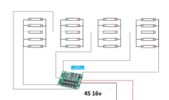I have tried to make a picture with the planned wiring of my battery and charging. It is based on 2.5-4.2V. I put them together in 4S, 10v-16.8V. I plan on charging them with a 120w charger, see link, it is rated at 20v, 6a, maximum. I see each cell has a discharge maximum of 30A continious. This might be a noob question, but is this the highest safe output for my batteries when they are connected in 4S 16.8v configuration too? I would not be able to power an electric motor with these batteries if the motor and the motorcontroller, vesc, is set to discharge 40 amps continiously? I see the 4S bms has a limit of 40 amps. What about a motor pulling 70 amps at 12-16V. If I was to use the batteries for Ebikes I would probably make the batteries higher voltage, but would this increase the amps too? does it increase the total wattage the battaries can handle watt = ampere x volt. If the 1s 3.7v battery can handle 30a x 3.7v = about 120w, would I be able to do more than 120w if I go up to higher voltage with 4s, could I expect more than 120w, lets say 40a x 16v=640w, or would it allways be maximum 30amps? If I put the batteries in parallell, does this increase the amps i can discharge/charge? If I have two batteries of 3.7V in parallel, does this make 3.7v x 60a = about 240w discharge?
-
Categories
-
Platforms
-
Content


